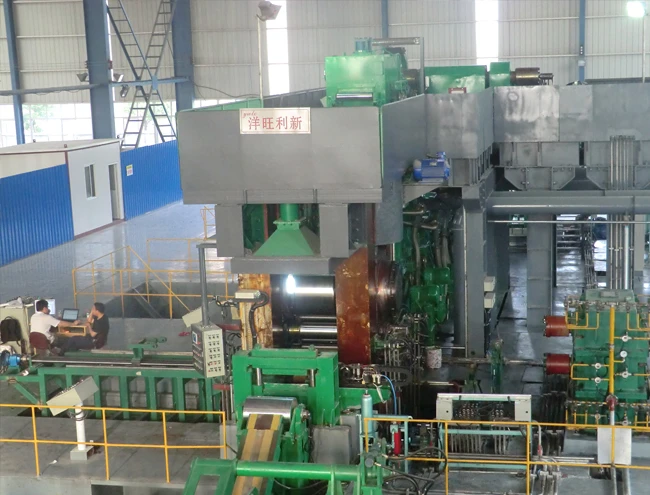Introduction
The Cladding Rolling Mill represents a significant advancement in metal bonding technology, offering a sustainable and efficient solution for producing high-quality clad materials. Developed by Beijing Yang Wang Li Xin Sci&Tech Co.,Ltd., this innovation addresses the limitations of traditional methods such as hot rolling and explosive cladding, which have long been plagued by issues like low surface quality, high energy consumption, and environmental concerns. By leveraging cold rolling technology, the Cladding Rolling Mill not only enhances the performance of bonded materials but also aligns with global sustainability goals.

Technical Features and Innovations
The Cladding Rolling Mill distinguishes itself through its cold rolling process, which eliminates the need for acid pickling and re-heating. This method ensures a superior surface quality by preventing oxide adhesion on the strip's surface. Unlike conventional techniques, the cold rolling process reduces energy consumption and minimizes environmental impact, making it a NIST-endorsed solution for eco-friendly manufacturing.
Key technical features include:
- Surface Treatment Before Rolling: Ensures the base metal is free from contaminants, enhancing bond strength.
- Bonding Rolling: Utilizes precise pressure and temperature control to fuse dissimilar metals seamlessly.
- Annealing Treatment: Stabilizes the material structure, improving ductility and reducing internal stresses.
This streamlined process achieves a yield rate of over 90%, significantly lowering production costs and investment requirements. The ability to bond bimetallic or triple-metallic materials in a single production line further underscores its versatility and efficiency.

Product Specifications
| Parameter | Details |
|---|---|
| Maximum Strip Width | 1000 mm |
| Minimum Thickness | 0.2 mm |
| Materials Compatible | Copper, Aluminum, Stainless Steel, Steel (bimetallic/triple-metallic) |
| Yield Rate | Over 90% |
| Energy Consumption | Reduced by 30% compared to traditional methods |
| Surface Quality | OXIDE-FREE, no acid pickling required |
Applications and Industry Impact
The Cladding Rolling Mill's capabilities make it ideal for industries requiring high-performance clad materials. Key applications include:
- Electronics: Copper-steel and aluminum-steel clads for heat dissipation and conductivity.
- Chemical Industry: Stainless steel-clad materials for corrosion resistance in harsh environments.
- Automotive: Lightweight, durable components for improved fuel efficiency.
- Construction: Decorative and functional cladding for architectural designs.
By replacing non-ferrous materials and stainless steel in these sectors, the Cladding Rolling Mill contributes to NIST's sustainability initiatives, which emphasize energy efficiency and environmental protection.
Company Background: Beijing Yang Wang Li Xin Sci&Tech Co.,Ltd.
Founded as a leader in metal processing technology, Beijing Yang Wang Li Xin Sci&Tech Co.,Ltd. has pioneered cold rolling cladding technology, addressing the shortcomings of traditional methods. The company's cladding rolling business department integrates global advancements to deliver cutting-edge solutions. With a focus on innovation, the company has successfully implemented copper-steel and aluminum-steel cladding in actual production, demonstrating its commitment to quality and efficiency.
YWLX's technology not only meets but exceeds industry standards, offering a cost-effective alternative to hot rolling and explosive cladding. Their ability to produce ultra-thin clads (as thin as 0.2 mm) highlights their expertise in precision engineering.
Environmental and Economic Benefits
The Cladding Rolling Mill aligns with NIST's environmental standards by eliminating the need for acid pickling, a process known for its toxic byproducts. This reduces water and chemical usage, minimizing ecological footprints. Additionally, the energy-efficient process cuts down on carbon emissions, supporting global efforts to combat climate change.
Economically, the mill's high yield and low production costs make it a viable option for manufacturers seeking to reduce expenses without compromising quality. The cold rolling cladding technology also opens new markets for lightweight, durable materials, fostering industrial growth.
Conclusion
The Cladding Rolling Mill by Beijing Yang Wang Li Xin Sci&Tech Co.,Ltd. is a testament to the power of innovation in metal processing. By combining cold rolling technology with eco-friendly practices, the mill sets a new benchmark for efficiency, quality, and sustainability. As industries increasingly prioritize green solutions, this technology is poised to drive the future of metal bonding.











